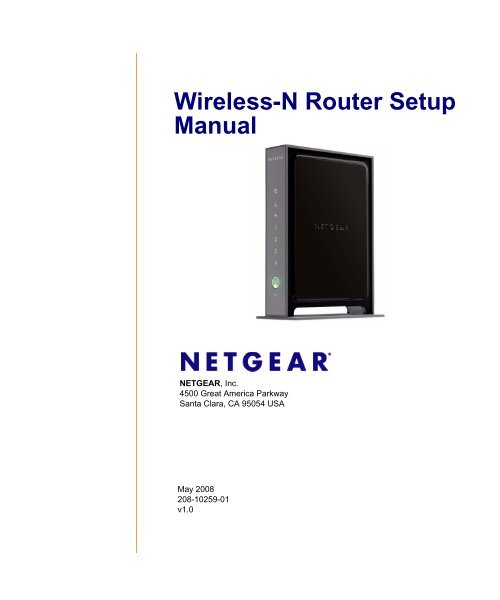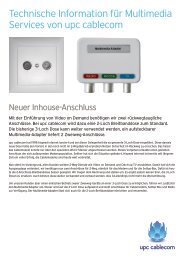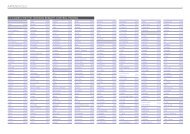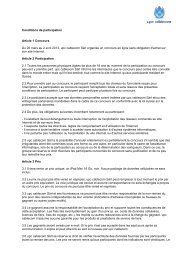Installing Your Wireless Router - upc cablecom
Installing Your Wireless Router - upc cablecom
Installing Your Wireless Router - upc cablecom
Create successful ePaper yourself
Turn your PDF publications into a flip-book with our unique Google optimized e-Paper software.
<strong>Wireless</strong>-N <strong>Router</strong> Setup<br />
Manual<br />
NETGEAR, Inc.<br />
4500 Great America Parkway<br />
Santa Clara, CA 95054 USA<br />
May 2008<br />
208-10259-01<br />
v1.0
©2008 by NETGEAR, Inc. All rights reserved.<br />
Trademarks<br />
NETGEAR and the NETGEAR logo are trademarks of NETGEAR. Inc. Microsoft, Windows, and Windows NT are<br />
registered trademarks of Microsoft Corporation. Wi-Fi Protected Setup is a trademark of the Wi-Fi Alliance. Other brand<br />
and product names are registered trademarks or trademarks of their respective holders.<br />
Statement of Conditions<br />
In the interest of improving internal design, operational function, and/or reliability, NETGEAR reserves the right to<br />
make changes to the products described in this document without notice.<br />
NETGEAR does not assume any liability that may occur due to the use or application of the product(s) or circuit<br />
layout(s) described herein.<br />
ii
<strong>Wireless</strong>-N <strong>Router</strong> Setup Manual<br />
Contents<br />
Getting to Know <strong>Your</strong> <strong>Wireless</strong> <strong>Router</strong> ................................................................................ 1<br />
Unpacking <strong>Your</strong> New <strong>Router</strong> ............................................................................................. 1<br />
Hardware Features ............................................................................................................ 3<br />
Front Panel .................................................................................................................. 3<br />
Back Panel .................................................................................................................. 5<br />
<strong>Router</strong> Label ................................................................................................................6<br />
Positioning <strong>Your</strong> <strong>Wireless</strong> <strong>Router</strong> ...................................................................................... 6<br />
Updating <strong>Your</strong> <strong>Router</strong> Firmware ........................................................................................ 7<br />
Setting Up <strong>Your</strong> <strong>Wireless</strong> Security ..................................................................................... 7<br />
<strong>Installing</strong> <strong>Your</strong> <strong>Wireless</strong> <strong>Router</strong> .......................................................................................... 7<br />
<strong>Installing</strong> <strong>Your</strong> <strong>Router</strong> Using the Smart Wizard................................................................... 9<br />
Using the Smart Wizard ..................................................................................................... 9<br />
Accessing <strong>Your</strong> <strong>Router</strong> After Installation ......................................................................... 10<br />
Manually <strong>Installing</strong> <strong>Your</strong> <strong>Router</strong> ......................................................................................... 11<br />
Connecting <strong>Your</strong> <strong>Wireless</strong> <strong>Router</strong> .................................................................................... 12<br />
Verifying <strong>Your</strong> Connection ............................................................................................... 15<br />
Setting Up <strong>Your</strong> <strong>Router</strong> for Internet Access ..................................................................... 16<br />
Configuring <strong>Your</strong> <strong>Wireless</strong> Network................................................................................... 21<br />
Specifying <strong>Wireless</strong> Settings ........................................................................................... 21<br />
Setting <strong>Your</strong> SSID and <strong>Wireless</strong> Security Manually .................................................. 21<br />
Using Push 'N' Connect (WPS) to Configure <strong>Your</strong> <strong>Wireless</strong> Network ....................... 23<br />
Testing Basic <strong>Wireless</strong> Connectivity ................................................................................ 26<br />
Troubleshooting................................................................................................................... 29<br />
Basic Setup Checklist ...................................................................................................... 29<br />
Checking Basic <strong>Router</strong> Functions ................................................................................... 30<br />
Troubleshooting Login Problems ..................................................................................... 32<br />
iii
Checking the Internet Service Connection ...................................................................... 33<br />
Obtaining an Internet IP Address .................................................................................... 33<br />
Troubleshooting PPPoE ............................................................................................ 34<br />
Troubleshooting Internet Browsing ........................................................................... 35<br />
Using the Ping Utility to Troubleshoot .............................................................................. 35<br />
Testing the Path from <strong>Your</strong> Computer to <strong>Your</strong> <strong>Router</strong> ............................................... 35<br />
Testing the Path from a Computer to the Internet ..................................................... 36<br />
Technical Specifications ..................................................................................................... 37<br />
Default Configuration Settings ......................................................................................... 37<br />
Restoring the Default Password and Configuration Settings ........................................... 39<br />
Related Documents..............................................................................................................41<br />
Registration and Certifications............................................................................................ 43<br />
iv
Getting to Know <strong>Your</strong> <strong>Wireless</strong> <strong>Router</strong><br />
Congratulations on your purchase of a NETGEAR® high-speed wireless router, the <strong>Wireless</strong>-N<br />
<strong>Router</strong> Model WNR2000.<br />
Before you begin installing your router, check the package contents (see “Unpacking <strong>Your</strong> New<br />
<strong>Router</strong>” on page 1). Become familiar with the front and back panels of your router—especially the<br />
status lights—and the important information on the router label (see “Hardware Features” on<br />
page 3). Then, read the section on “Positioning <strong>Your</strong> <strong>Wireless</strong> <strong>Router</strong>” on page 6 to ensure that you<br />
have selected the best location to install your router.<br />
Unpacking <strong>Your</strong> New <strong>Router</strong><br />
<strong>Your</strong> product package should contain the following items:<br />
• The <strong>Wireless</strong>-N <strong>Router</strong><br />
• A snap-on stand for your wireless router<br />
• An AC power adapter (varies by region)<br />
• A yellow Ethernet cable<br />
• The Resource CD, which includes:<br />
– The Smart Wizard Installation Assistant (Autorun.exe)<br />
– A PDF version of this manual<br />
– A link to the online User Manual<br />
A link to the online User Manual is also available from the router interface,<br />
after the router is installed. Click Documentation on the main menu.<br />
– (A link to the online User Manual is also available from the router interface, after the<br />
router is installed).<br />
• Warranty and Support Information cards<br />
If any of the parts are incorrect, missing, or damaged, contact your NETGEAR dealer. Keep the<br />
carton, including the original packing materials, in case you need to return the product for repair.<br />
Getting to Know <strong>Your</strong> <strong>Wireless</strong> <strong>Router</strong> 1
To prepare your router for installation:<br />
1. Carefully peel off the protective film covering both sides of your router (see Figure 1).<br />
Figure 1<br />
2. Set up your wireless router by inserting the tabs of the stand (supplied with your router) into<br />
the slots on the bottom of your router as shown in Figure 2. Then, remove the protective film<br />
covering the status light panel of the router.<br />
Figure 2<br />
3. Place your router in a suitable area for installation (near an AC power outlet and accessible to<br />
the Ethernet cables for your wired computers).<br />
To ensure proper heat dissipation and for router stability, it is important that you<br />
connect the stand and place your router in an upright position.<br />
2 Getting to Know <strong>Your</strong> <strong>Wireless</strong> <strong>Router</strong>
Hardware Features<br />
Before you install and connect your router, take a moment to become familiar with the front and<br />
back panels of the router—especially the status lights on the front panel.<br />
Front Panel<br />
The router front panel, shown in Figure 3, contains status lights. (For more information on<br />
interpreting the status lights, see “Verifying <strong>Your</strong> Connection” on page 15 and “Checking Basic<br />
<strong>Router</strong> Functions” on page 30.)<br />
Figure 3<br />
1<br />
2<br />
3<br />
4<br />
5<br />
Getting to Know <strong>Your</strong> <strong>Wireless</strong> <strong>Router</strong> 3
You can use the status lights to verify various conditions. Table 1 describes each light.<br />
Table 1. Status Light Descriptions<br />
Label LED Activity Description<br />
1. Power<br />
2. Internet<br />
3. <strong>Wireless</strong><br />
4. LAN<br />
(Ports 1–4)<br />
5. Push 'N'<br />
Connect<br />
Solid Amber<br />
Solid Green<br />
Fast blink–Green<br />
Slow blink–Green<br />
Off<br />
Solid Amber<br />
Solid Green<br />
Blinking Green<br />
Off<br />
Solid Blue<br />
Blinking Blue<br />
Off<br />
Solid Green<br />
Blinking Green<br />
Solid Amber<br />
Blinking Amber<br />
Off<br />
Solid Green<br />
Blinking Green<br />
Off<br />
The router is performing the power-on self-test diagnostic.<br />
The power is on and the router is ready.<br />
A software update is in progress.<br />
There is a problem with the wireless router software.<br />
Power is not being supplied to the router<br />
No IP address acquired.<br />
The wireless router has acquired an Internet address.<br />
Data is being communicated with the Internet.<br />
No Ethernet cable is connected to the modem.<br />
The wireless interface is enabled.<br />
Data is being communicated over the wireless network.<br />
The wireless interface is turned off.<br />
The local port is connected to a 100 Mbps device.<br />
Data is being transmitted at 100 Mbps.<br />
The local port is connected to a 10 Mbps device.<br />
Data is being transmitted at 10 Mbps.<br />
No link is detected on this port.<br />
Indicates a (WPS) connection to a WPS-capable device.<br />
WPA-capable device can associate with the router within 2 minutes.<br />
No WPS connection exists.<br />
4 Getting to Know <strong>Your</strong> <strong>Wireless</strong> <strong>Router</strong>
Back Panel<br />
The router back panel, shown in Figure 4, contains port connections.<br />
Figure 4<br />
1<br />
2<br />
3<br />
4<br />
5<br />
Viewed from top to bottom, the rear panel contains the following elements:<br />
1. Restore factory settings button. Press for approximately 5 seconds to reset the router to the<br />
factory default settings.<br />
2. Four Local Area Network (LAN) 10/100 Mbps Ethernet ports for connecting the router to<br />
your local computers.<br />
3. Internet/Wide Area Network (WAN) Ethernet port for connecting the router to a cable or DSL<br />
modem.<br />
4. Power on/off push-button.<br />
5. AC power adapter outlet for connecting the power adapter.<br />
Getting to Know <strong>Your</strong> <strong>Wireless</strong> <strong>Router</strong> 5
<strong>Router</strong> Label<br />
The label on the back of the wireless router shows the router’s MAC address, serial number,<br />
security PIN, and factory default login information.<br />
The ports on the router are color-coded to distinguish your Internet port from the other four ports<br />
that connect to the wired computer(s) on your Local Area Network (LAN).<br />
Figure 5<br />
Positioning <strong>Your</strong> <strong>Wireless</strong> <strong>Router</strong><br />
The wireless router lets you access your network from virtually anywhere within the operating<br />
range of your wireless network. However, the operating distance or range of your wireless<br />
connection can vary significantly depending on the physical placement of your router. For<br />
example, the thickness and number of walls the wireless signal must pass through might limit the<br />
range. For best results, place your router:<br />
• Near the center of the area where your computers and other devices will operate, preferably<br />
within line of sight to your wireless devices.<br />
• Accessible to an AC power outlet and near Ethernet cables for wired computers.<br />
• In an elevated location such as a high shelf, keeping the number of walls and ceilings between<br />
the wireless router and your other devices to a minimum.<br />
• Away from electrical devices which are potential sources of interference, such as ceiling fans,<br />
home security systems, microwaves, or the base for a cordless phone.<br />
• Away from any large metal surfaces, such as a solid metal door or aluminum studs. Large<br />
expanses of other materials such as glass, insulated walls, fish tanks, mirrors, brick, and<br />
concrete can also affect your wireless signal.<br />
Failure to follow these guidelines can result in significant performance degradation<br />
or an inability to wirelessly connect to the Internet.<br />
6 Getting to Know <strong>Your</strong> <strong>Wireless</strong> <strong>Router</strong>
Updating <strong>Your</strong> <strong>Router</strong> Firmware<br />
NETGEAR is always improving the operability and features included with your router. To make it<br />
easy for you to receive the best, most up-to-date features of your router, NETGEAR provides a<br />
variety of methods for updating your product.<br />
• The Smart Wizard Installation Assistant lets you check for and install updates as part of the<br />
setup activity (see “Using the Smart Wizard” on page 9).<br />
• The router includes an update feature that lets you check for and install updates. You must log<br />
in to the router to use this feature see “Setting Up <strong>Your</strong> <strong>Router</strong> for Internet Access” on<br />
page 16, or the online User Manual).<br />
Setting Up <strong>Your</strong> <strong>Wireless</strong> Security<br />
To make it easy for you to select the security that best fits your network, NETGEAR provides<br />
several methods for configuring security:<br />
• The Smart Wizard offers to guide you in setting up security at initial setup (see “Using the<br />
Smart Wizard” on page 9).<br />
• If you have any devices (a notebook, adapter, or other device) that support Wi-Fi Protected<br />
Setup (WPS), you can enable WPS security (see “Using Push 'N' Connect (WPS) to Configure<br />
<strong>Your</strong> <strong>Wireless</strong> Network” on page 23).<br />
• The router’s <strong>Wireless</strong> Settings screen lets you set your <strong>Wireless</strong> Network connections and<br />
select the appropriate and optimum security options for your network and router (see “Setting<br />
<strong>Your</strong> SSID and <strong>Wireless</strong> Security Manually” on page 21).<br />
<strong>Installing</strong> <strong>Your</strong> <strong>Wireless</strong> <strong>Router</strong><br />
To help you set up your router and get on the Internet quickly, the Resource CD contains a Smart<br />
Wizard Installation Assistant. The Installation Assistant walks you through the steps required to<br />
Getting to Know <strong>Your</strong> <strong>Wireless</strong> <strong>Router</strong> 7
connect your router, modem, and PC(s); configure your wireless settings; and enable wireless<br />
security for your network. When you have finished, you will be Internet ready!<br />
NETGEAR does not recommend or support adding a NETGEAR router behind<br />
another router, or replacing a gateway with a a NETGEAR router.<br />
If you have a Macintosh or Linux system, you need to use the manual installation<br />
method (see “Manually <strong>Installing</strong> <strong>Your</strong> <strong>Router</strong>” on page 11).<br />
You can set up your wireless router using one of two methods:<br />
• Smart Wizard Setup: The Smart Wizard Installation Assistant setup is available on your<br />
Resource CD. See “<strong>Installing</strong> <strong>Your</strong> <strong>Router</strong> Using the Smart Wizard” on page 9 to use the<br />
Smart Wizard Installation Assistant.<br />
– This is the easiest option. The wizard guides you through the setup process. It automates<br />
many of the steps and verifies that the steps have been successfully completed.<br />
– Smart Wizard requires a PC running Microsoft Windows.<br />
Before running the Smart Wizard Installation Assistant on a corporate PC to<br />
set up your home router, check with your company’s network support staff.<br />
Corporate network settings or Virtual Private Network (VPN) client<br />
software might conflict with the default settings of a home router. If you are<br />
unsure about whether there might be a conflict, use a different computer.<br />
• Manual Setup: If you cannot or prefer not to use the Smart Wizard Installation Assistant, see<br />
“Manually <strong>Installing</strong> <strong>Your</strong> <strong>Router</strong>” on page 11. For example, if you are connecting to a Mac,<br />
are using a Linux operating system, or are technically knowledgeable, select this option. If you<br />
choose to use this option and install your router manually, for best results, install and set up<br />
your router in this order:<br />
1. Install and connect your wireless router to your network (see “Connecting <strong>Your</strong> <strong>Wireless</strong><br />
<strong>Router</strong>” on page 12).<br />
2. Set up your wireless router for Internet access (see “Setting Up <strong>Your</strong> <strong>Router</strong> for Internet<br />
Access” on page 16).<br />
3. Configure your wireless network and select wireless security settings to protect your<br />
wireless network (see “Configuring <strong>Your</strong> <strong>Wireless</strong> Network” on page 21).<br />
8 Getting to Know <strong>Your</strong> <strong>Wireless</strong> <strong>Router</strong>
<strong>Installing</strong> <strong>Your</strong> <strong>Router</strong><br />
Using the Smart Wizard<br />
The Smart Wizard setup procedure should take about 15 minutes to complete. Before using the<br />
Smart Wizard to set up your router, ensure that:<br />
• You are using a PC with Windows Vista, Windows 2000, or Windows XP with Service Pack 2,<br />
and with a wired Ethernet connection, not a wireless connection.<br />
• You have an Internet service connection through an Internet Service Provider (ISP).<br />
• You have the configuration information provided by your ISP.<br />
Using the Smart Wizard<br />
The NETGEAR Smart Wizard takes you through the procedure to connect your router, modem,<br />
and PC(s). It then helps you to configure your wireless settings and enable wireless security for<br />
your network. The Smart Wizard guides you through the setup process by automating many of the<br />
steps. At each step in the setup process, the Smart Wizard checks to ensure that the steps you<br />
perform are successfully completed.<br />
To install your router using the Smart Wizard:<br />
1. Insert the Resource CD into your Windows PC. The CD will automatically start and detect the<br />
language you are using on your PC. Select a different language option, if you prefer.<br />
If the CD does not automatically start, browse the CD and double-click on .<br />
2. In the CD’s menu, click Setup to start the Smart Wizard.<br />
3. When the Smart Wizard prompts you about updates, click Yes to check for updates for your<br />
router, or No, to update later (for more information, see “Setting Up <strong>Your</strong> <strong>Router</strong> for Internet<br />
Access” on page 16, or the online User Manual).<br />
4. Follow the remaining instructions and prompts.<br />
<strong>Installing</strong> <strong>Your</strong> <strong>Router</strong> Using the Smart Wizard 9
The Smart Wizard guides you through installing your router, connecting your router to the<br />
Internet, configuring your wireless network settings, and selecting the optimum security<br />
protection for your network. If you choose not to select a security option during installation,<br />
you can always access the router’s user interface later to select a security option (see<br />
“Configuring <strong>Your</strong> <strong>Wireless</strong> Network” on page 21).<br />
You are now connected to the Internet.<br />
Figure 6<br />
To ensure optimum performance of your high-speed wireless router, the<br />
wireless adapter card for each computer in your network should support the<br />
same technology as your router. For more information, see the online User<br />
Manual.<br />
<br />
To set up additional wireless computers in your network to access the router and connect to the<br />
Internet, see “Configuring <strong>Your</strong> <strong>Wireless</strong> Network” on page 21.<br />
Accessing <strong>Your</strong> <strong>Router</strong> After Installation<br />
<br />
The Smart Wizard only appears when you first install the router or when the router is in its factory<br />
default state (for example, if you have reset the router to its default factory settings). If you want to<br />
change the settings after installing and configuring your router using the Smart Wizard, you must<br />
open a browser window and log in to the router. You will also be prompted to check for new router<br />
firmware. For more information, see “Configuring <strong>Your</strong> <strong>Wireless</strong> Network” on page 21.<br />
10 <strong>Installing</strong> <strong>Your</strong> <strong>Router</strong> Using the Smart Wizard
Manually <strong>Installing</strong> <strong>Your</strong> <strong>Router</strong><br />
Before installing and connecting your router manually, review the list below and make sure that<br />
you have all of the necessary information.<br />
Use the procedures in this topic if you are an advanced user, or a user of Macintosh<br />
and Linux systems.<br />
• Internet service connection through an Internet Service Provider (ISP).<br />
• The configuration information your ISP gave you. Depending on how your Internet account<br />
was set up, you might need the following information to set up your wireless router and access<br />
the Internet:<br />
– Host and domain name<br />
– Internet login name and password (frequently an email address and password)<br />
– Domain Name Server (DNS) addresses<br />
– Fixed or static IP address<br />
<strong>Your</strong> ISP should have provided you with all the information needed to connect to the Internet.<br />
If you cannot locate this information, ask your ISP.<br />
• If you have cable modem service, make sure that you are using the same computer on which<br />
you first set up your Internet account.<br />
If you have not already done so:<br />
• Check the package contents of your router to ensure that it is complete (see “Unpacking <strong>Your</strong><br />
New <strong>Router</strong>” on page 1”).<br />
• Select an optimum location for your wireless router after reviewing the guidelines presented in<br />
“Positioning <strong>Your</strong> <strong>Wireless</strong> <strong>Router</strong>” on page 6.”<br />
Manually <strong>Installing</strong> <strong>Your</strong> <strong>Router</strong> 11
Connecting <strong>Your</strong> <strong>Wireless</strong> <strong>Router</strong><br />
Before you install your wireless router, make sure that the Internet Protocol (TCP/IP) Property<br />
settings on your computer are set to “automatically obtain an IP address” using DHCP and “Obtain<br />
DNS server address automatically.” You can check these settings by looking at the TCP/IP<br />
Properties of your Internal Network Connections, which are accessible through the Control Panel<br />
of your computer. If you are unsure about this, refer to the documentation for your computer or see<br />
the link to TCP/IP Addressing in “Related Documents” on page 41.<br />
If you are replacing an existing router, disconnect it completely from your network and set it aside<br />
before starting to install your new router. Then, skip to step 5 in the following procedure<br />
To connect the wireless router, the computer, and the modem:<br />
1. Turn off your computer.<br />
2. Turn off and unplug the cable or DSL broadband modem.<br />
3. Locate the cable (A) that connects your computer to the modem.<br />
4. Disconnect the cable at the modem end only (B). You will connect it to the router later.<br />
Figure 7<br />
NETGEAR does not recommend or support adding a NETGEAR router behind<br />
another router, or replacing a gateway with a NETGEAR router.<br />
B<br />
A<br />
12 Manually <strong>Installing</strong> <strong>Your</strong> <strong>Router</strong>
5. Locate the Ethernet cable that came with your NETGEAR product. Securely insert one end of<br />
the Ethernet cable into your modem (C) and the other end into the Internet port of the wireless<br />
router (D). (The cable and the Internet port label are color coded.)<br />
<br />
D<br />
Figure 8<br />
6. Locate the cable (A) that is still attached to your computer (see step 4). Securely insert that<br />
cable into a port on the router, such as port 4 (E), as shown in Figure 9.<br />
Figure 9<br />
<br />
<br />
<br />
<br />
A<br />
C<br />
1<br />
2<br />
3<br />
4<br />
<br />
Internet<br />
7. Connect any additional wired PCs to your router by inserting an Ethernet cable from a PC into<br />
one of the three remaining LAN ports.<br />
Manually <strong>Installing</strong> <strong>Your</strong> <strong>Router</strong> 13<br />
E
8. Review that your network is now set up (as shown in Figure 10); you are ready to start your<br />
network.<br />
Figure 10<br />
<br />
9. Start your network in the correct sequence, as described below.<br />
To start your network:<br />
1. Plug in and turn on the cable or DSL modem. Wait 2 minutes.<br />
<br />
Failure to start or restart your network in the correct sequence could prevent you<br />
from accessing the Internet.<br />
2. Plug the end of the power adapter’s cord into the wall or a power strip, and into the power<br />
adapter outlet of your wireless router (F). Wait 1 minute.<br />
14 Manually <strong>Installing</strong> <strong>Your</strong> <strong>Router</strong>
Figure 11<br />
3. Turn on your computer. It will take several minutes for your router to establish a connection<br />
with your computer and your Internet provider.<br />
Verifying <strong>Your</strong> Connection<br />
1<br />
2<br />
3<br />
4<br />
Internet<br />
For DSL customers, if software logs you in to the Internet, do not run that<br />
software. You might need to go to the Internet Explorer Tools menu, Internet<br />
Options, Connections tab and select “Never dial a connection.”<br />
Verify that your router is connected correctly by checking the wireless router status lights (as<br />
illustrated in Figure 12).<br />
Manually <strong>Installing</strong> <strong>Your</strong> <strong>Router</strong> 15<br />
F
Figure 12<br />
Setting Up <strong>Your</strong> <strong>Router</strong> for Internet Access<br />
When configuring your wireless router manually, you must log in to your wireless router to set it<br />
up initially and to make any changes to your wireless router’s settings later.<br />
To access the router:<br />
Power. The power light should turn solid green. If it does not, see<br />
“Checking Basic <strong>Router</strong> Functions” on page 30.<br />
Internet. The Internet port light should be lit. If it is not, make sure the<br />
Ethernet cable is securely attached to the wireless router Internet port<br />
and the modem, and that the modem is powered on.<br />
<strong>Wireless</strong>. The wireless light should be lit after turning on the<br />
router.<br />
LAN. A LAN light (1-4) should be lit for each connected computer on<br />
your network. Green indicates that your computer is communicating<br />
at 100 Mbps; amber indicates communication at 10 Mbps. If a LAN<br />
light is not lit for each connected Ethernet cable, make sure that the<br />
Ethernet cable from the computer to the router is securely attached<br />
at both ends, and that the computer is turned on.<br />
WPS. The WPS button/light will not be lit unless you push it to enable<br />
Push ‘N’ Connect (WPS) security. See “Using Push 'N' Connect<br />
(WPS) to Configure <strong>Your</strong> <strong>Wireless</strong> Network” on page 23.<br />
The factory default state is reset when you use the Restore Factory Settings button.<br />
See “Restoring the Default Password and Configuration Settings” on page 39 for<br />
more information.<br />
1. Type http://www.routerlogin.net in the address field of your browser, and then click Enter.<br />
You can enter either of these addresses to connect to your wireless router:<br />
http://www.routerlogin.net or http://www.routerlogin.com.<br />
16 Manually <strong>Installing</strong> <strong>Your</strong> <strong>Router</strong>
A login window similar to the one shown in Figure 13 will display.<br />
Figure 13<br />
2. When prompted, enter admin for the router user name and password for the router password,<br />
both in lowercase letters. (For security reasons, the router has its own user name and<br />
password.)<br />
The router user name and password are not the same as any user name or<br />
password you might use to log in to your Internet connection.<br />
The Firmware Upgrade Assistant screen will display.<br />
3. Click Yes to check for new firmware (recommended). The router will automatically check the<br />
NETGEAR database for a new firmware image file. If no new firmware version is available,<br />
the message “No New Firmware Version Available” will display. (If you select “No,” you can<br />
check for new firmware later; see the online User Manual.)<br />
4. If new firmware is available, click Yes, and the router will automatically upgrade itself with<br />
the latest firmware.<br />
Do not try to go online, turn off the router, shut down the computer, or do<br />
anything else to the router until the router finishes restarting! When the Ready<br />
light stops blinking, wait a few seconds more before using the router.<br />
Manually <strong>Installing</strong> <strong>Your</strong> <strong>Router</strong> 17
5. From the menu options in the left navigation pane, click Setup Wizard. The Setup Wizard<br />
screen will display.<br />
Figure 14<br />
6. Select one of the following options:<br />
• Select Yes to allow the Setup Wizard to detect your Internet connection. When prompted,<br />
click Next. The wizard will assist you with configuring your wireless router to access the<br />
Internet.<br />
If you cannot connect to the wireless router, check the Internet Protocol<br />
(TCP/IP) properties in the Network Connections section of your Control<br />
Panel. It should be set to obtain both IP and DNS server addresses<br />
automatically. For assistance, see your computer documentation or see the<br />
links in “Related Documents” on page 41.<br />
• Select No to set up the connection yourself. Click Next and the Basic Settings screen will<br />
display. Enter the required information for your ISP connection in the appropriate fields. If<br />
you need assistance, follow the Basic Settings Help screens on the router interface or see<br />
the online User Manual for this wireless router.<br />
For more information about configuring settings, see “Configuring <strong>Your</strong><br />
<strong>Wireless</strong> Network” on page 21.<br />
7. Click Apply to save your settings and complete your connection.<br />
You should now be connected to the Internet!<br />
18 Manually <strong>Installing</strong> <strong>Your</strong> <strong>Router</strong>
If you do not connect successfully:<br />
• Review your settings and make sure that you have selected the correct options and typed<br />
everything correctly.<br />
• Contact your ISP to verify that you have the correct configuration information.<br />
• Read “Troubleshooting” on page 29.<br />
If problems persist, register your NETGEAR product and contact NETGEAR Technical Support.<br />
Manually <strong>Installing</strong> <strong>Your</strong> <strong>Router</strong> 19
20 Manually <strong>Installing</strong> <strong>Your</strong> <strong>Router</strong>
Configuring <strong>Your</strong> <strong>Wireless</strong> Network<br />
This section describes additional configuration and testing for your network, after you have<br />
performed basic installation of the <strong>Wireless</strong>-N <strong>Router</strong>.<br />
For a wireless connection, the router and each wireless computer must use the same SSID, also<br />
called the wireless network name, and the same wireless security. NETGEAR strongly<br />
recommends that you use wireless security.<br />
Indoors, computers can connect over wireless networks at a range of several hundred<br />
feet. This can allow others outside of your immediate area to access your network.<br />
Specifying <strong>Wireless</strong> Settings<br />
The <strong>Wireless</strong> Settings screen lets you set your wireless network connections and the wireless<br />
security option for your network and router. To configure the wireless network, you can either<br />
manually specify your network name (SSID) and your wireless security settings (see “Setting <strong>Your</strong><br />
SSID and <strong>Wireless</strong> Security Manually” on page 21) or, if the clients in your network are WPS<br />
capable, you can use Wi-Fi Protected Setup (WPS) to automatically set the SSID and implement<br />
WPA/WPA2 security on both the router and the client device (see “Using Push 'N' Connect (WPS)<br />
to Configure <strong>Your</strong> <strong>Wireless</strong> Network” on page 23).<br />
If you configure the router from a wireless computer and you change the router’s<br />
SSID, channel, or security settings, you will lose your wireless connection when<br />
you click Apply. You must then change your computer’s wireless settings to match<br />
the router’s new settings. To avoid this situation, you can use a computer that is<br />
connected to the router with an Ethernet cable.<br />
For a complete overview of all the security configurations that can be implemented on this router,<br />
see the online User Manual.<br />
Setting <strong>Your</strong> SSID and <strong>Wireless</strong> Security Manually<br />
To specify the wireless settings, you must know the following:<br />
• SSID. The default SSID for the router is NETGEAR.<br />
Configuring <strong>Your</strong> <strong>Wireless</strong> Network 21
• The wireless mode (802.11g/b, or 802.11n) that each wireless adapter supports.<br />
• <strong>Wireless</strong> security option. NETGEAR strongly recommends that you use wireless security. To<br />
successfully implement wireless security, check each wireless adapter to determine which<br />
wireless security option it supports.<br />
To set up basic wireless connectivity:<br />
1. Log in to the wireless router as described in “To access the router:” on page 16.<br />
2. On the main menu, select <strong>Wireless</strong> Settings to display the <strong>Wireless</strong> Settings screen.<br />
Note that the default SSID is NETGEAR.<br />
The SSID of any wireless adapters must match the SSID you configure in the<br />
wireless router. If they do not match, you will not get a wireless connection.<br />
3. Set the Region. Select the region where the router is located.<br />
4. Leave the wireless mode at its default setting.<br />
5. Click Apply to save your changes.<br />
To set up your computers for wireless connectivity:<br />
1. Program the wireless settings of each computer or wireless adapter to have the same SSID<br />
(wireless network name) as the router.<br />
2. Check that the wireless adapter on each computer can support the mode and security option<br />
that you selected. (If you have a question, see the online User Manual or review the settings<br />
you selected previously).<br />
3. Check that the security settings on each wireless device match the security settings of the<br />
router. For example, if you selected a security option requiring a passphrase, then the same<br />
passphrase must be used for each wireless computer.<br />
4. Check that each wireless computer has a wireless link and is able to obtain an IP address by<br />
DHCP from the router.<br />
For a Windows PC, go to the Control Panel and select Network Connections.<br />
Check the <strong>Wireless</strong> Connections Properties and ensure that TCP/IP Properties<br />
are set to Obtain an IP address automatically.<br />
22 Configuring <strong>Your</strong> <strong>Wireless</strong> Network
To access the Internet from any computer connected to your wireless router, launch a browser such<br />
as Microsoft Internet Explorer or Netscape Navigator. You should see the wireless router’s Internet<br />
LED blink, indicating communication to the ISP.<br />
Using Push 'N' Connect (WPS) to Configure <strong>Your</strong> <strong>Wireless</strong><br />
Network<br />
If your wireless clients support Wi-Fi Protected Setup (WPS), you can use this feature to configure<br />
the router’s SSID and security settings and, at the same time, connect the wireless client securely<br />
and easily to the router (computers that will connect wirelessly to the router are clients). Look for<br />
the symbol on your client device. 1 WPS automatically configures the SSID and wireless<br />
security settings for the router (if the router is in its default state) and broadcasts these settings to<br />
the wireless client.<br />
NETGEAR’s Push 'N' Connect feature is based on the Wi-Fi Protected Setup (WPS)<br />
standard. All other Wi-Fi-certified and WPS-capable products should be compatible<br />
with NETGEAR products that implement Push 'N' Connect.<br />
If the router has already been configured manually, and either WPS-PSK or WPA2-PSK security<br />
has been enabled, a wireless client can be connected quickly and simply by using the WPS method<br />
of connecting to the wireless network. In this case, the router preserves its existing wireless<br />
settings and broadcasts them to the WPS-capable client.<br />
If you choose to use WPS, the only security methods supported are WPA-PSK and<br />
WPA2-PSK. WEP security is not supported by WPS.<br />
If you install a NETGEAR adapter that supports WPS, its installation procedures guide you<br />
through a WPS connection without the need to log in to the router. However, if you wish to<br />
perform any WPS connection using the router settings, use the procedures below. (For more<br />
information on setting up a mixed network, see the online User Manual.<br />
To add a WPS client to your network:<br />
1. Log in to the wireless router, type http://www.routerlogin.net or http://<br />
www.routerlogin.com in the address field of your browser, and then click Enter.<br />
1. For a list of other Wi-Fi-certified products available from NETGEAR, go to http://www.wi-fi.org.<br />
Configuring <strong>Your</strong> <strong>Wireless</strong> Network 23
2. On the router main menu, select Add a WPS Client. The Add WPS Client wizard screen<br />
displays. Click Next.<br />
3. Select the method for adding the WPS client. A WPS client can be added using the pushbutton<br />
method or the PIN method.<br />
• Using the Push-Button. This is the preferred method.<br />
– Select the Push-Button radio box and either press the WPS push-button on the router<br />
or click the soft WPS push-button on the screen (as shown below).<br />
– The router will attempt to communicate with the client; you have 2 minutes to enable<br />
WPS from the client device using the client’s WPS networking utility.<br />
:<br />
Figure 15<br />
Figure 16<br />
• Entering a PIN. If you want to use the PIN method, select the PIN radio box. A screen<br />
similar to the one shown below displays.<br />
– Go to your wireless client and, from the client’s WPS utility, obtain the wireless<br />
client’s security PIN, or follow the client’s WPS utility instructions to generate a<br />
security PIN.<br />
24 Configuring <strong>Your</strong> <strong>Wireless</strong> Network
– Then, enter this PIN in the Enter Client’s PIN field provided on the router and click<br />
Next. You have 4 minutes to enable WPS on the router using this method.<br />
Figure 17<br />
Using either method, the client wireless device will attempt to detect the WPS signal from the<br />
router and establish a wireless connection in the time allotted.<br />
• If no connection is detected:<br />
– WPS did not establish a secure connection with a wireless device.<br />
– Neither the SSID nor the WPA/WPA2 security settings were configured on the router.<br />
• If a connection is established:<br />
– The router WPS screen displays a message confirming that the wireless client was<br />
successfully added to your wireless network.<br />
– The router generated an SSID, implemented WPA/WPA2 wireless security (including<br />
a PSK security password), and broadcast these settings to the client; the client now<br />
shares the same security settings as the router.<br />
If the router was already configured manually, and either WPS/PSK or<br />
WPA2/PSK security enabled and a PSK security password selected, then<br />
the client now shares these same security settings.<br />
4. Note your SSID and WPA/WPA2 PSK security password (whether previously set or<br />
generated) for your wireless network.<br />
Configuring <strong>Your</strong> <strong>Wireless</strong> Network 25
To access the Internet from any computer connected to your wireless router, launch a browser such<br />
as Microsoft Internet Explorer or Netscape Navigator. You should see the wireless router’s Internet<br />
LED blink, indicating communication to the ISP.<br />
If you are planning a mixed network of WPS capable devices and non-WPS capable<br />
devices, NETGEAR suggests that you set up your wireless network and security<br />
settings manually first, and only use WPS for adding the WPS capable devices.<br />
For more information on setting up your wireless network and configuring your wireless security<br />
settings, see the online User Manual.<br />
Testing Basic <strong>Wireless</strong> Connectivity<br />
Once you have established basic wireless connectivity, you can enable security settings<br />
appropriate to your needs.<br />
To set up and test basic wireless connectivity:<br />
1. Log in to the wireless router as described in “To access the router:” on page 16.<br />
2. Click <strong>Wireless</strong> Settings in the main menu.<br />
3. Note whatever SSID you have set up.<br />
The SSID of any wireless adapters must match the SSID you configure in the<br />
wireless router. If they do not match, you will not get a wireless connection. If<br />
you are configuring the router from a wireless computer and you change the<br />
router’s SSID, channel, or security settings, you will lose your wireless<br />
connection when you click Apply. You must then change the wireless settings of<br />
your computer to match the router’s new settings.<br />
4. Configure and test your computers for wireless connectivity.<br />
Program the wireless adapter of your computers to have the same wireless network name<br />
(SSID) as the wireless router. Check that they have a wireless link and are able to obtain an IP<br />
address by DHCP from the router.<br />
<strong>Your</strong> wireless router is now configured to provide Internet access for your network. <strong>Your</strong> wireless<br />
router automatically connects to the Internet when one of your computers requires access. It is not<br />
necessary to run a dialer or login application such as Dial-Up Networking or Enternet to connect,<br />
26 Configuring <strong>Your</strong> <strong>Wireless</strong> Network
log in, or disconnect. These functions are performed automatically by the wireless router as<br />
needed.<br />
To access the Internet from any computer connected to your wireless router, launch a browser such<br />
as Microsoft Internet Explorer or Netscape Navigator. You should see the wireless router’s Internet<br />
LED blink, indicating communication to the ISP. The browser should begin to display a Web page.<br />
Configuring <strong>Your</strong> <strong>Wireless</strong> Network 27
28 Configuring <strong>Your</strong> <strong>Wireless</strong> Network
Troubleshooting<br />
If you have difficulties accessing the Internet, use the Basic Setup Checklist to make sure that you<br />
have connected and set up your router correctly. If your basic setup is correct, then look for your<br />
problem in one of the subsequent sections.<br />
For more information, refer to the online User Manual. A link to this document is<br />
included on the Resource CD, and is also available from the router interface, after the<br />
router is installed. Click Documentation on the main menu.<br />
Basic Setup Checklist<br />
The following items are the most common errors made when initially setting up a router. Carefully<br />
review the checklist to make sure that you have followed the recommended procedures.<br />
• Be sure you always start your network in this sequence:<br />
1. Turn off and unplug the modem from the power outlet. Next, turn off the wireless router<br />
and computer.<br />
2. Turn on the modem and wait 2 minutes.<br />
3. Turn on the wireless router and wait 1 minute.<br />
4. Turn on the computer.<br />
• Make sure the Ethernet cables are securely plugged in.<br />
– The Internet status light on the wireless router will be lit if the Ethernet cable to the<br />
wireless router from the modem is plugged in securely and the modem and wireless router<br />
are both turned on (see “Connecting <strong>Your</strong> <strong>Wireless</strong> <strong>Router</strong>” on page 12).<br />
– For each powered-on computer connected to the wireless router with a securely pluggedin<br />
Ethernet cable, the corresponding wireless router LAN port status light will be lit. The<br />
label on the back of the wireless router identifies the number of each LAN port (see<br />
“Restore factory settings button. Press for approximately 5 seconds to reset the router to<br />
the factory default settings.” on page 5).<br />
• Make sure the network settings of the computer are correct.<br />
Troubleshooting 29
– LAN connected computers must be configured to obtain an IP address automatically using<br />
DHCP. For more information, see the links in “Related Documents” on page 41.<br />
– Some cable modem services require you to use the MAC address of the computer<br />
registered on the account. If so, in the <strong>Router</strong> MAC Address section of the Basic Settings<br />
menu, select “Use this Computer’s MAC Address.” Click Apply to save your settings.<br />
Restart the network in the correct sequence.<br />
• Check the router status lights to verify correct router operation. If the Power light does<br />
not turn solid green within 2 minutes after turning the router on, reset the router according to<br />
the instructions in “Restoring the Default Password and Configuration Settings” on page 39.<br />
Checking Basic <strong>Router</strong> Functions<br />
After you turn on power to the router, check that the following sequence of events has occurred:<br />
1. When power is first applied, verify that the power light is on (see “Front Panel” on page 3 for<br />
an illustration).<br />
2. Verify that the power light turns amber within a few seconds, indicating that the self-test<br />
procedure is running.<br />
3. After approximately 20 seconds, verify that:<br />
a. The color of the power light changes to green.<br />
b. The LAN port lights are lit for any local ports that are connected.<br />
If a port’s light is lit, a link has been established to the connected device. If a LAN port is<br />
connected to a 100 Mbps device, verify that the port’s light is green. If the port is 10 Mbps,<br />
the light will be amber.<br />
c. The Internet port is connected and its light is lit.<br />
4. If you have enabled WPS security, verify that the push-button stops blinking and changes to<br />
green (otherwise the push-button light should be off).<br />
If the correct behavior does not occur, check for a remedy from the following list:<br />
• Power Light Not On. If the Power and other lights are off (see “Connecting <strong>Your</strong> <strong>Wireless</strong><br />
<strong>Router</strong>” on page 12), check the following:<br />
– Make sure that the power cord is properly connected to your router and that the power<br />
adapter is properly connected to a functioning power outlet.<br />
– Check that you are using the power adapter supplied by NETGEAR for this product.<br />
30 Troubleshooting
•<br />
If the error persists, you have a hardware problem and should contact technical support.<br />
Power Light Blinks Green Slowly and Continuously. The router firmware is corrupted.<br />
To restore your firmware:<br />
a. Make sure your PC is connected to your router and the router is powered on.<br />
b. Insert the Resource CD that came with your router into your PC.<br />
– The CD will automatically start and detect the language you are using on your PC.<br />
Select a different language option, if you prefer.<br />
– If the CD does not automatically start, browse the CD and double-click on .<br />
c. Click Supporting Software, then Netgear Firmware Recovery Utility, and follow the<br />
prompts for the recovery process.<br />
d. After firmware recovery is complete, follow the prompts to restore your configuration<br />
settings.<br />
• Power Light Stays Amber. When the router is turned on, the Power light turns amber for<br />
about 20 seconds and then turns green. If the light does not turn green, the router has a<br />
problem.<br />
If the Power light is still amber 1 minute after turning on power to the router:<br />
a. Turn the power off and back on to see if the router recovers.<br />
b. Clear the router’s configuration to factory defaults. This will set the router’s IP address to<br />
192.168.1.1. This procedure is explained in “Restoring the Default Password and<br />
Configuration Settings” on page 39.<br />
•<br />
If the error persists, you might have a hardware problem and should contact technical support.<br />
Internet Light Stays Amber. When the router is turned on, the Internet light turns amber for<br />
about 20 seconds and then turns green. If the light does not turn green, the router has a<br />
problem.<br />
If the Internet light is still amber 1 minute after turning on power to the router:<br />
a. The Internet is not accessible. Confirm that you have the correct internet setting.<br />
b. Clear the router’s configuration to factory defaults. This will set the router’s IP address to<br />
192.168.1.1. This procedure is explained in “Restoring the Default Password and<br />
Configuration Settings” on page 39.<br />
c. Turn the power off and back on to see if the router recovers.<br />
Troubleshooting 31
• Internet or LAN Port Lights Not On. If either the LAN or Internet lights do not light when<br />
the Ethernet connection is made, check the following:<br />
a. Make sure that the Ethernet cable connections are secure at the router and at the computer.<br />
b. Make sure that power is turned on to the connected computer.<br />
c. Be sure you are using Ethernet cables like the cable that was supplied with the wireless<br />
router.<br />
See “Connecting <strong>Your</strong> <strong>Wireless</strong> <strong>Router</strong>” on page 12 for instructions.<br />
For more information on WPS functionality and advanced features, see the online User Manual.<br />
Troubleshooting Login Problems<br />
If you are unable to log in to the wireless router, check the following:<br />
• If you are using an Ethernet-connected computer, check the Ethernet connection between the<br />
computer and the router as described in “Checking Basic <strong>Router</strong> Functions” on page 30.<br />
• Make sure you are using the correct login information. The factory default login name is<br />
admin and the password is password. Make sure that the Caps Lock is off when entering this<br />
information.<br />
• Make sure your computer’s IP address is on the same subnet as the router. If your are using the<br />
recommended addressing scheme, your computer’s address should be in the range of<br />
192.168.1.2 to 192.168.1.254. Refer to your computer’s documentation or see “Preparing a<br />
Computer for Network Access” in “Related Documents” on page 41 for help with configuring<br />
your computer.<br />
If your computer cannot reach a DHCP server, some operating systems will<br />
assign an IP address in the range 169.254.x.x. If your IP address is in this range,<br />
verify that you have a good connection from the computer to the router, then<br />
restart (reboot) your computer.<br />
• If your router’s IP address has been changed and you don’t know the current IP address, reset<br />
the router’s configuration to the factory defaults. This procedure will reset the router’s IP<br />
address to 192.168.1.1 (see “Restoring the Default Password and Configuration Settings” on<br />
page 39).<br />
• Make sure your browser has Java, JavaScript, or ActiveX enabled. If you are using Internet<br />
Explorer, click Refresh to be sure the Java applet is loaded. Try closing the browser and<br />
reopening it again.<br />
32 Troubleshooting
• If you are attempting to set up your NETGEAR router as an additional router behind an<br />
existing router in your network, consider replacing the existing router instead. NETGEAR<br />
does not support such a configuration.<br />
• If you are attempting to set up your NETGEAR router as a replacement for an ADSL gateway<br />
in your network, the router cannot perform many gateway services, for example, converting<br />
ADSL or Cable data into Ethernet networking information. NETGEAR does not support such<br />
a configuration.<br />
Checking the Internet Service Connection<br />
If your router is unable to access the Internet, check the Internet connection, and then check the<br />
wireless router.<br />
• Internet Connection. The cable or DSL modem status lights indicate if the modem<br />
connection is successful or not. Check your modem documentation or call your Internet<br />
service provider for help with verifying that the modem has a successful connection.<br />
• <strong>Wireless</strong> <strong>Router</strong> Internet Light is Green or Blinking Green. If your Internet light is green<br />
or blinking green, then you have a good Internet connection and your wiring is correct.<br />
• <strong>Wireless</strong> <strong>Router</strong> Internet Light Off. If the Internet light is off, verify that the Ethernet cable<br />
is securely connected between the cable or DSL modem, and that both the modem and<br />
wireless router are turned on.<br />
Obtaining an Internet IP Address<br />
If your wireless router is unable to access the Internet, and your Internet light is amber, check the<br />
wireless router to see if it is able to get an Internet IP address from your service provider. Unless<br />
you have a static IP address, your wireless router automatically requests an IP address from your<br />
service provider.<br />
To check the Internet IP address from the browser interface:<br />
1. Log in to the wireless router.<br />
2. Select the <strong>Router</strong> Status link under the Maintenance heading to check that an IP address is<br />
shown for the Internet Port. If 0.0.0.0 is shown, your wireless router has not obtained an IP<br />
address from your service provider.<br />
If your router is unable to obtain an IP address from the your service provider, the problem might<br />
be one of the following:<br />
Troubleshooting 33
• <strong>Your</strong> service provider might require a login. Ask your service provider whether they require a<br />
PPP over Ethernet (PPPoE) login.<br />
• You might have incorrectly set the service name, user name or password. See<br />
“Troubleshooting PPPoE” on page 34.<br />
• <strong>Your</strong> service provider might check for your computer's host name. Assign the computer Host<br />
Name of your ISP account to the wireless router on the Basic Settings screen.<br />
• <strong>Your</strong> service provider might only allow one Ethernet MAC address to connect to the Internet,<br />
and check for your computer’s MAC address. If this is the case:<br />
– Inform your service provider that you have bought a new network device, and ask them to<br />
use the wireless router’s MAC address, or<br />
– Configure your router to spoof your computer’s MAC address. On the Basic Settings<br />
screen in the <strong>Router</strong> MAC Address section, select “Use this Computer’s MAC Address”<br />
and click Apply. Then restart your network in the correct sequence (see “Basic Setup<br />
Checklist” on page 29).<br />
Troubleshooting PPPoE<br />
If you are using PPPoE, try troubleshooting your Internet connection.<br />
To troubleshoot a PPPoE connection:<br />
1. Log in to the wireless router.<br />
2. Select <strong>Router</strong> Status under Maintenance on the main menu.<br />
3. Click Connection Status. If all of the steps indicate “OK,” then your PPPoE connection is up<br />
and working.<br />
If any of the steps indicate “Failed,” you can attempt to reconnect by clicking Connect. The<br />
wireless router will continue to attempt to connect indefinitely.<br />
If you cannot connect after several minutes, you might be using an incorrect service name,<br />
user name, or password. There also might be a provisioning problem with your ISP.<br />
Unless you connect manually, the wireless router will not authenticate using<br />
PPPoE until data is transmitted to the network.<br />
34 Troubleshooting
Troubleshooting Internet Browsing<br />
If your wireless router can obtain an IP address but your computer is unable to load any web pages<br />
from the Internet, check the following:<br />
• <strong>Your</strong> computer might not recognize any DNS server addresses. A DNS server is a host on<br />
the Internet that translates Internet names (such as www addresses) to numeric IP addresses.<br />
Typically, your ISP will provide the addresses of one or two DNS servers for your use. If you<br />
entered a DNS address during the wireless router’s configuration, restart your computer.<br />
Alternatively, you can configure your computer manually with a DNS address, as explained in<br />
the documentation for your computer.<br />
• <strong>Your</strong> computer might not have the wireless router configured as its default gateway.<br />
Reboot the computer and verify that the wireless router address (192.168.1.1) is listed by your<br />
computer as the default gateway address.<br />
Using the Ping Utility to Troubleshoot<br />
Most computers and routers have a diagnostic utility called ping that sends a request to a target<br />
device. The device then replies. The ping utility makes it easy to troubleshoot a network.<br />
Testing the Path from <strong>Your</strong> Computer to <strong>Your</strong> <strong>Router</strong><br />
You can ping the wireless router to verify that the LAN path from your computer to your router is<br />
set up correctly.<br />
To ping the wireless router from a Windows PC:<br />
1. From the Windows task bar, click Start and select Run.<br />
2. In the field provided, type ping followed by the address of the router, as in this example:<br />
ping www.routerlogin.net<br />
3. Click OK. You should see a message like this one:<br />
Pinging www.routerlogin.net with 32 bytes of data<br />
If the path is working, you see this message:<br />
Reply from www.routerlogin.net: bytes=32 time=NN ms TTL=xxx<br />
If the path is not working, you see this message:<br />
Request timed out<br />
If the path is not working correctly, you could have one of the following problems:<br />
Troubleshooting 35
• Wrong physical connections<br />
– Make sure the LAN port light is on. If the light is off, follow the instructions in “Basic<br />
Setup Checklist” on page 29.<br />
– Check that the corresponding lights are on for your computer’s network interface card.<br />
• Wrong network configuration<br />
– Verify that the Ethernet card driver software and TCP/IP software are both installed and<br />
configured on your computer.<br />
– Verify that the IP addresses for your router and your computer are correct and that both<br />
addresses are on the same subnet (for example, 192.168.1.x/255.255.255.0).<br />
Testing the Path from a Computer to the Internet<br />
After verifying that the path between your computer and the wireless router works correctly, test<br />
the path from your PC to the Internet.<br />
To test the path using ping from a Windows PC:<br />
1. From the Windows task bar, click Start and select Run.<br />
2. In the field provided, type cmd. A command screen will display.<br />
3. At the > prompt, type the following:<br />
ping -n 10 <br />
where is the IP address of a remote device such as your ISP’s DNS server.<br />
4. Press Enter.<br />
If the path is working correctly, replies as in the previous section will display. If you do not receive<br />
replies:<br />
• Check that your PC has the IP address of your router listed as the default gateway. If the IP<br />
configuration of your PC is assigned by DHCP, this information will not be visible in your<br />
PC’s Network Control Panel. Verify that the IP address of the router is listed as the TCP/IP<br />
default gateway.<br />
• Check to see that the network address of your PC (the portion of the IP address specified by<br />
the netmask) is different from the network address of the remote device.<br />
• If your ISP assigned a host name to your PC, enter that host name as the Account Name in the<br />
Basic Settings menu.<br />
36 Troubleshooting
Default Configuration Settings<br />
Technical Specifications<br />
This section provides factory default settings and technical specifications for the <strong>Wireless</strong>-N<br />
<strong>Router</strong> Model WNR2000.<br />
Table 2. Home <strong>Router</strong> Default Configuration Settings<br />
Feature Default Setting<br />
<strong>Router</strong> Login<br />
<strong>Router</strong> Login URL http://www. routerlogin.net;<br />
http://www.routerlogin.com; or http://192.168.1.1<br />
Login Name (case sensitive) admin<br />
Login Password (case sensitive)<br />
Internet Connection<br />
password<br />
WAN MAC Address Default hardware address (on label)<br />
MTU Size<br />
Local Network<br />
1500<br />
<strong>Router</strong> Lan IP address (the Gateway IP<br />
address)<br />
192.168.1.1<br />
IP Subnet Mask 255.255.255.0<br />
DHCP Server Enabled<br />
Time Zone GMT<br />
Time Zone Adjusted for Daylight Saving<br />
Time<br />
Firewall<br />
Disabled<br />
Inbound (communications coming in from Disabled (bars all unsolicited requests except for<br />
the Internet)<br />
traffic on port 80, the http port)<br />
Outbound (communications going out to<br />
the Internet)<br />
Enabled (all)<br />
Technical Specifications 37
Table 2. Home <strong>Router</strong> Default Configuration Settings (continued)<br />
Feature Default Setting<br />
<strong>Wireless</strong><br />
<strong>Wireless</strong> Communication Enabled<br />
SSID Name NETGEAR<br />
Security Disabled<br />
Broadcast SSID Enabled<br />
Transmission Speed Autoa Country/Region United States (North America only; otherwise varies<br />
by country and region)<br />
RF Channel 11 in North America, 13 in most other regions<br />
Operating Mode Up to 145 Mbps<br />
Data Rate Best<br />
Output Power Full<br />
a. Maximum <strong>Wireless</strong> signal rate derived from IEEE Standard 802.11 specifications. Actual throughput will vary. Network<br />
conditions and environmental factors, including volume of network traffic, building materials and construction, and network<br />
overhead lower actual data throughput rate.<br />
38 Technical Specifications
Restoring the Default Password and Configuration<br />
Settings<br />
You can restore the factory default configuration settings that reset the router’s user name to<br />
admin, the password to password, and the IP address to 192.168.1.1.<br />
This procedure will erase all the current configuration settings and restore the factory<br />
defaults.<br />
To restore the factory default configuration settings:<br />
1. Use a sharp object such as a pen or a paper clip to press and hold the restore factory settings<br />
button, located on the rear panel of the router, for about 5 seconds, until the Power light begins<br />
to blink (see “Back Panel” on page 5).<br />
2. Release the restore factory settings button, and wait for the router to restart, and for the Power<br />
light to stop blinking and become solid green.<br />
The factory default settings will be restored so that you can access the router from your Web<br />
browser using the factory defaults.<br />
Technical Specifications 39
40 Technical Specifications
Related Documents<br />
This section provides links to reference documents that you can use to gain a more complete<br />
understanding of the technologies used in your NETGEAR product.<br />
Table 3. Related Documents<br />
Document Link<br />
Internet Networking and<br />
TCP/IP Addressing<br />
Preparing a Computer<br />
for Network Access<br />
http://documentation.netgear.com/reference/enu/tcpip/index.htm<br />
http://documentation.netgear.com/reference/enu/wsdhcp/index.htm<br />
Glossary http://documentation.netgear.com/reference/enu/glossary/index.htm<br />
Related Documents 41
42 Related Documents
Product Registration, Support, and Documentation<br />
Registration and Certifications<br />
Register your product at http://www.NETGEAR.com/register. You must register before you can use our telephone<br />
support service. Product updates and Web support are always available by going to: http://www.NETGEAR.com/support.<br />
Setup documentation is available on the CD, on the support website, and on the documentation website. When the<br />
wireless router is connected to the Internet, click the KnowledgeBase link to view support information or click the<br />
Documentation link to view the online User Manual for this wireless router.<br />
Maximum <strong>Wireless</strong> Signal Rate Derived from IEEE Standard 802.11 Specifications<br />
Actual data throughput will vary. Network conditions and environmental factors, including volume of network traffic,<br />
building materials and construction, and network overhead, lower actual data throughput rate.<br />
Federal Communications Commission (FCC) Compliance Notice: Radio Frequency Notice<br />
This equipment has been tested and found to comply with the limits for a Class B digital device, pursuant to part 15 of<br />
the FCC Rules. These limits are designed to provide reasonable protection against harmful interference in a residential<br />
installation. This equipment generates, uses, and can radiate radio frequency energy and, if not installed and used in<br />
accordance with the instructions, may cause harmful interference to radio communications. However, there is no<br />
guarantee that interference will not occur in a particular installation. If this equipment does cause harmful interference to<br />
radio or television reception, which can be determined by turning the equipment off and on, the user is encouraged to try<br />
to correct the interference by one or more of the following measures:<br />
• Reorient or relocate the receiving antenna.<br />
• Increase the separation between the equipment and receiver.<br />
• Connect the equipment into an outlet on a circuit different from that to which the receiver is connected.<br />
• Consult the dealer or an experienced radio/TV technician for help.<br />
43

















